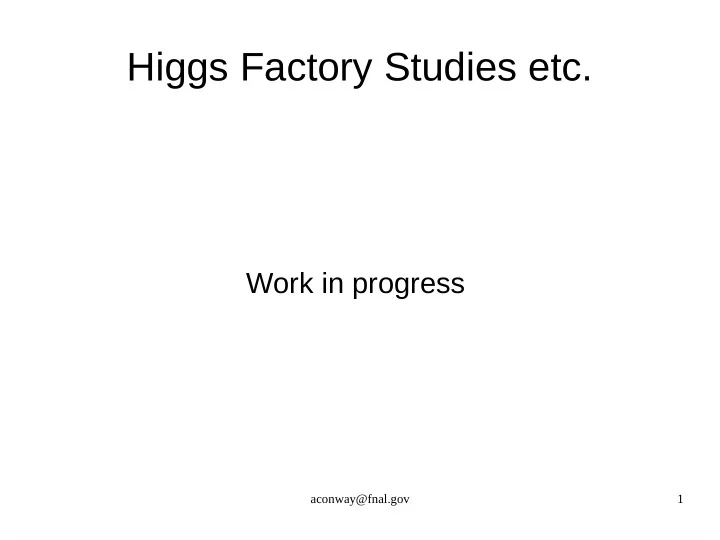

Higgs Factory Studies etc. Work in progress aconway@fnal.gov 1
Higgs Cross Section vs Beam Width ● Peak value of SM 125GeV Higgs Breit- Wigner convoluted with Gaussian beam. ● Does not include initial state radiation effects – These reduce the total cross section to about half (~52-58%) aconway@fnal.gov 2
Machine Parameters ● 0.003% spread→ 2.65MeV at 125GeV ● Higgs x-section = 37.4pb with this spread ● 1x10^32/cm^2/s = 1x10^-5 pb^-1/s – = 1.7x10^2 pb^-1 / Snowmass year – → 6.4x10^3 Higgs/yr (on-peak) 3
Higgs Signal vs Background ● No initial state radiation effects included. – Expected to increase background and decrease signal – Background here not used. ● R=0.003% (2.65MeV) beam smearing 4
Higgs Signal vs Background ● Pythia-simulated backgrounds ● – Includes some form of initial state radiation, using default settings, unclear how accurate. ● Using these backgrounds for now. Good enough? ● Same backgrounds as spring report – Higgs cross sections slightly larger. 5
Higgs Measurements ● Process: – Choose total luminosity, bin spacing, energy range ● Bin spacing = beam gaussian width ● Energy range = Higgs c.o.m. +/- 25MeV – Simulate data ● Poisson-distributed random numbers with <N> = (s + b)*L. – Fit to Breit-Wigner convoluted with Gaussian ● Free parameters: – Higgs mass, width, branching fractions ● Known values: – Beam width, integraged luminosity, background cross section 6
Higgs Measurements ● Perfect b-tag and selective energy cuts – 52% signal, 15% of background – S/b = 1.3 ● Fit errors reflect accuracy to a decent degree – Could improve estimation with estimation of luminosity error. 7
Higgs Measurements ● WW*: – Four-lepton decay; ~16% of h0 → WW* signal, 1.3pb – 0.015pb background – S/b ~= 85 ● Not as good for width measurement ● What figures to quote for uncertainty? 8
Software and Computing Status ● Attempting to create/document working simulation and reconstruction environment. – https://confluence.slac.stanford.edu/display/MCPDS/Simulation+and+Reconstruction ● Using: – Pythia (or other stdhep event generator) and MadGraph5 – SLIC detector simulation – ILCSoft reconstruction tools: PandoraPFA algorithms – Org.lcsim, JAS3 and NetBeans ● Port Steve Magill's dual-readout analysis tools for SiD to MCDRCal ● Set up environment on mcdrd machine for use ● Set up environment for submitting simulation jobs to GRID 9
Software and Computing Status ● Pythia/MadGraph5 – Working fine – Instructions for generating accurate muon collider events would be good. ● SLIC – Getting warnings during simulations with new mcdrcal01, talking to Jeremy. – Simulated dataset had read error after one event. ● ILCSoft – ilcinstall scripts – slicPandora (package for PandoraPFA) doesn't build currently. – Generally somewhat tricky to get set up in a given environment. – Have identified some bugs and gotten them resolved. ● Org.lcsim, JAS3 et al. – Winter tutorial instructions still apply – Have not worked on Steve Magill's dual readout code yet. Will bring it to the mcd.analysis project on CVS ● GRID – Have not looked into it yet, but will probably take some work. GRID experts? – Will be necessary for full event simulaitons 10
Recommend
More recommend